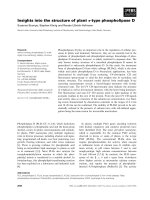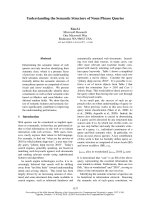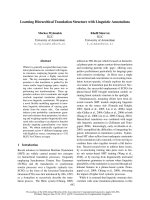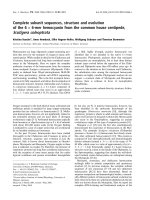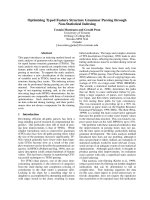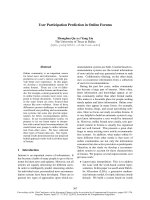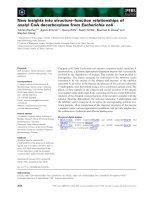Báo cáo khoa học: "USER MODELLING, DIALOG STRUCTURE, DIALOG STRATEGY IN RAM-ANS" potx
Bạn đang xem bản rút gọn của tài liệu. Xem và tải ngay bản đầy đủ của tài liệu tại đây (533.97 KB, 6 trang )
USER MODELLING, DIALOG STRUCTURE, AND
DIALOG STRATEGY IN RAM-ANS
Katharina Morik
Technische Universitaet Berlin
Project group KIT , Sekr. FR 5-8
Franklinstr. 28/29
D-IO00 Berlin i0 (Fed. Rep. Germany)
ABSTRACT
AI dialog systems are now developing from
question-answering systems toward advising
systems. This includes:
discussed here, but see (Jameson, Wahlster 1982).
The
second part
of
this paper presents user
modelling with respect to a dialog strategy which
selects and verbalizes the appropriate speech act
of recommendation.
- structuring dialog
- understanding
and
generating
a
wider range
of
speech acts than simply information request and
answer
-
user modelling
User modelling in HAM-ANS is closely connected to
dialog structure and dialog strategy. In advising
the user, the system generates and verbalizes
speech acts. The choice of the speech act is
guided by the user profile and the dialog strategy
of the system.
INTRODUCTION
The HAMburg Application-oriented Natural language
System (HAM-ANS) which has been developed for 3
years is now accomplished. We could perform
numerous dialogs with the system thus determining
the advantages and shortcomings of our approach
(Hoeppner at al. |984). So now the time has come
to show the open problems and what we have learned
as did the EUFID group when they accomplished
their system (Templeton, Burger 1983). This paper
does not evaluate the overall HAM-ANS but is
restricted to the aspect of dialog structuring and
user modelling.
Dialog structure is represented at two levels: the
outline of the dialog is explicitly represented by
a top (evel routine, embedded sub-dialogs are a
result of the processing strategy of HAM-ANS. The
overall dialog structure is utilized for
determining the appropriate degree of detail of
the referential knowledge for a particular dialog
phase. The embedded sub-dialogs refer to other
knowledge sources than the referential knowledge.
In the first part of this paper dialog structuring
in HAM-ANS is described. Handling of dialog
phenomena as ellipsis and anaphora is not
DIALOG STRUCTURE
In one of its three applications HAM-ANS plays the
role of a hotel clerk who advises the user in
selecting a suitable room. The task of advising
can be seen here as a comparison of the demands
made on an object by the client and the advisor's
knowledge about available objects, performed in
order to determine the suitability of an object
for the client. Dialogs between hotel clerks at
the reception and the becoming hotel guest are
usually short and stereotyped but offer some
flexibility as well because the ~ruests do not
establish a homogeneous group. With recourse to
this restricted dialog type we modelled the
outline of the dialog. Dialog structure is not
represented in terms of some actions the user
might want to perform as did Grosz (1977), Allen
(1979), Litman,Allen (1984) nor in terms of
information goals of the user as did Pollack
(1984), but we represent and use knowledge about a
dialog type. For formal dialogs in a well defined
comunication setting this is possible. For a
practical application the dialog phases and steps
should be empirically determined. We do not
consider the hotel reservation situation an
example for real application. We just wanted to
show the feasibility of recurring to linguistic
knowledge about types of texts or dialogs. Real
clerk - guest dialogs show some features we did
not concern. Features of informal man-man-
communication as, e.g., narratives and role-
defining utterances of dialog partners were
excluded from the model
of
the dialog. Man-
machine-interaction is seen as formal as opposed
to informal communication, and there is no way of
redefining it as personal talk.
The outline of the dialog is a structure at three
different levels: there are three dialog phases,
each consisting of several dialog steps (see
Fig. l). Each dialog step can be performed by
several dialog acts.
* The work on HAM-ANS has been supported by the
BMFT (Bundesministerium fuer Forschung und
Technologic) under contract 08it15038.
Although the outline of the dialog is fixed, there
is also flexibility to some extent:
268
GREETING
FINDING OUT WHAT THE USER WANTS
CONFIRMATION
RECOMMENDING A ROOM
\
giving the initiative
\
ANSWERING QUESTIONS ABOUT THAT PARTICULAR ROOM
/
taking the initiative
BOOKING THE ROOM (OR NOT)
:GOOD-BYE
Fig. l outline of the dialog
- The dialog step "Finding out what the user
wants" consists of as many questions of the
system as are necessary
- If the confirmation step does not succeed it is
jumped back to the dialog act where the user
initializes the dialog step "Finding out what
the user wants
- In the dialog phase concerning a particular
room the system asks for regaining the
initiative. If the user denies the questioning
phase is continued.
The advantages of fully utilizing knowledge about
the dialog type are the reduction of complexity,
i.e. the system does not have to recognize the
dialog step, realistic response time because no
additional processing has to be done for planning
the dialog, and the explicit representation of the
dialog structure. The declarative representation
of dialog structure allows for modelling different
degrees of detail of the world knowledge attached
to the dialog phases.
Views of the domain
We believe that the degree of detail of
referential knowledge is constituing a dialog
phase. In other words, different degrees of detail
or abstraction seperate dialog phases. Reichman
could have made this point, because her empirical
data do support this observation (Reichman 1978).
In focus is not only a certain portion of a task
tree or a certain step in a plan, but also a
certain view of the matter. Therefore, attached
to the dialog phases are different knowledge bases
accessable in these phases. World knowledge
contains for the first and the last phase overview
knowledge about the hotel and its room categories,
for the second phase detailed knowledge about one
instance of a room category, i.e. a particular
room.
The room categories are derived from the
individual rooms by an extraction process which
disregards location and special features of
objects as, e.g., colour. But representing
overview knowledge is not just leaving out some
types of arcs in the referential semantic network!
One capability of the extraction process is to
group objects together if there is an available
word to identify the group and to identify objects
which are members of the group not just parts of a
whole. An example may clarify this.
One advantage of some of the rooms is that they
have a comfortable seating arrangement made up of
various objects: couch, chairs, coffee table, etc.
HAM-ANS can abstract from this grouping of objects
and identify it as a "Sitzecke" - a kind of cozy
corner, a common concept and an every-day word in
German. Another example of a group is the concept
"Zimmerbar" (room bar) consisting of a
refrigirator, drinking glasses and drinks.
Another difference between overview knowledge and
detailed knowledge is that some properties of
objects are inherited to the room category. For
example, what can be seen out of the window is
abstracted to the view of the room category. A
room category has a view of the Alster, one of the
two rivers of Hamburg, if at least one window
faces the Alster.
While selecting a suitable room for the user the
system accesses the abstracted referential
knowledge. Not until the dialog focuses on one
particular room, does the system answer in detail
questions about, e.g. the location of furniture,
its appearance, comfort,etc. Thus different
degrees of detail are associated with different
dialog phases because the tasks for which the
referential knowledge is needed differ. The link
between the overview information, e.g. that a room
category has a desk, a seating arrangement
("Sitzecke") etc., and the detailed referential
knowledge about a particular room of that
category, e.g., that there is a desk named DESKI,
that there are three arm chairs and a coffee table
etc., is established by an inverse process to the
extraction process. This inverse process finds
tokens or derives implicit types, for which in
turn the corresponding tokens are found. When
initiative is given to the user, the tokens of
objects mentioned in the preceeding dialog are
entered into the dialog memories which keep track
of what is mutually known by system and user.
Thus, if the seating arrangement ("Sitzecke") has
been introduced into the dialog the user may ask,
where "the coffee table" is located using the
definite description, because by naming the
seating arrangement the coffee table is implicitly
introduced.
The procedural connection between overview and
detailed knowledge entails, however, a problem.
First, while semantic relations between concepts
are represented in the conceptual network thus
determining noun meaning, the meaning of "group
nouns" could not be represented in the same
formalism. Second, inversing the extraction
process and entering tokens into a dialog memory
269
leads to a problem of ambiguous referents. If a
"Sitzecke" has been mentioned - which arm chairs
or couchs are introduced and how many? The system
may infer the tokens, but not the user. For him, a
default description of a "Sitzecke", which is
concretized only if an object is named by the
user, should be entered into the dialog memory.
Subdialogs
We have seen the outline of the dialog, but also
inside the questioning phase there is a dialog
structure. The system initiates a clarification
dialog if it could not understand the user input.
This could be, for instance, a lexicon update
dialog. The user may start a subdialog in putting
a meta-question as, e.g., "What was my last
question?" or "What is meant by carpet?". Maim-
questions are recognized by clue patterns. Here,
too, attached to the subdialogs are different
knowledge sources: subdialogs are not
referring
to the referential knowledge (about a particular
room) but to the lexical update package, the
dialog memories, or the conceptual knowledge.
Subdialogs are embedded dialogs which can be seen
in the system behavior regarding anaphora, for
instance. They are processed in bypassing the
normal procedure of parsing, interpretation and
generating. This solution should be replaced by a
dialog manager module which decides as a result of
the interpretation process which knowledge source
is to be taken as a basis for finding the answer.
USER MODELLING
User modelling in AI most often concerns the
user's familiarity with a computer system (Finin
1983, Wilensky 1984) or his/her knowledge of the
domain (Goldstein 1982, Clancey 1982, Paris 1983).
These are, of course, important aspects of user
modelling, but the system must in addition model
the user-assessment aspect.
Value judgements
The claim of philosophers and linguists (Hare
1952, Grewendorf 1978, Zillig 1982) that value
judgements refer to some sort of an evaluation
standard are not sufficient. In AI, the questions
are:
- how to recognize evaluation standards
- how to represent them
- how to use them for generating speech acts
evaluations should be used to select those objects
which might interest the user. For example, which
information about a hotel room is presented to the
user depends on the interests of the user and his
requirements, which can be inferred from his/her
evaluation standard. The information to be
outputted can be selected on the basis of user's
requirements rather than on the basis of freedom
of redundancy given the user's knowledge. Thus,
the choice of the relevant objects as well as the
choice of the appropriate value judgement requires
the modelling of the user's evaluation standards.
A system which performs recommendations of fiction
books is Rich's GRUNDY (Rich 1979). The basis
heuristic underlying the consultative function is
that people are interested in books in which
characters have the same type of personality as
they themselves have, or where characters are
facing a situation similar to their o~en.
Therefore, recognizing the personality type of a
user is a central concern for GRUNDY and can be
used directly for the evaluation of books. We'll
see that for HAM-ANS the utilization of knowledge
about the user is not so straightforward. Neither
is HAM-ANS interested in the personality type of
the user nor is there any plausible direct match
between personality type and room category. We
want to distinguish the user facts, which is
knowledge about the user and his wants given
explicitly by himself, the user profile, which is
knowledge about the user inferred by the system,
and the interest profile, which is the user's
evaluation standard as it is inferred by the
system. One has to be inferred from the other.
Building
the interest
profile
Let us look at an example of the first dialog
phase:
SYS :
USER:
SYS :
USER:
SYS :
USER:
SYS :
[t is well known that recommendations rely on the
presumed evaluation standards of the hearer. If
these speech acts are to be actually implemented USER:
in the system and not just read into the system
responses by the user, the system must be able to SYS :
reco~ni=e the user's stRndards of evaluation,
derive the demands placed by the user on objects
or situations which form the subject with the USER:
demands. [t would be overinformative to output
evaluations about every possible object. Rather, SYS :
HOTEL ALSTERBLICK, GUTEN ABEND!
At the sign of Hotel Alsterblick, good
even ing'
Hallo hier Doktor Heine von IBM Heidelberg,
Hello this is Doctor Heine from IBM
Heidelberg
WAS KANN ICH FUER SIE TUN?
What can I do for you?
Ich moechte ein Doppelzimmer mit Bad fuer
zwei Tage.
I would like a single room with bath for two
days.
UND AB WANN WIRD DAS ZIMMER BENOETIGT?
And for when would you like the room?
Ab morgan
For tomorrow
UND AUF WELCHEN NAMEN SOLL DAS ZI~4ER
GEBUCHT WERDEN?
And in whose name should the room be booked?
Auf meinen.
In
mine.
EIN DOPPELZIMMER BIS Zt~1 25.4. HAETTEN SIE
GERN?
You would like a double room until april 25?
Ja.
Yes.
UNSER HOTEL WIRD IHNEN GEFALLEN UND WIR
270
HABEN AUCH NOCH EIN ZIMMER FREI. DAS ZIMMER
HAT KEIN FERNSEHGERAET ABER EINE ZI~@4ERBAR,
EINEN SCHREIBTISCH, EIN TELEFON UND EINE
SITZECKE. HABEN SIE ZU DIESEM ZIMMER NOCH
EINE FRAGE?
You will enjoy our hotel and there is still
a room available. The room has no TV but a
room bar, a desk, a telephone, and a seating
arrangement. Do you have questions
concerning this room?
In this dialog phase the user first informs the
system about his concerns and indirectly give some
hints about his standards. The facts, i.e. from
when to when what kind of a room should be booked
for whom, are stored in a data structure under the
heading GUEST. If the user has not given all the
necessary information, the system asks for it.
The way the user introduces himself may give a
hint as to what kind of user he is. But the system
would not ask for title or firm or location if the
user has not volunteered the information. From
these data some inference processes are initiated,
estimating independently profession (here,
manager) financial status (here, rich), and
purpose of trip (here, transit). The estimations
are stored under the heading SUPPOSE. They can be
viewed as stereotypes in that they are
charcteristics of a person, relating him/her to a
certain group to which a number of features are
assigned (Gerard, Jones 1967). As I mentioned
earlier the application of stereotypes is not as
straightforward as in Rich's approach. Two steps
are required. We've just seen the first step, the
generation of SUPPOSE data. As opposed to GUEST
data, the SUPPOSE ata are not certain, thus
supposed data and facts are divided.
In the second step, each of the SUPPOSE data
independently triggers inferences, that derive
requirements presumably placed on a room and on
the hotel by the user. The requirements are
roughly weighed as very important, important and
surplus (extras). If the same requirement is
derived by more than one inference and with
different weights, the next higher weight is
created or the stronger weight is chosen,
respectively. This is, of course, a rather
simplified way of handling reinforcement. But a
more finely treatment would yield no practical
results in this domain. The requirements for the
room category and for the hotel are stored
seperately in semantic networks. An excerpt of the
networks corresponding to the dialog example
above:
((WICHTIG (HAT Z FERNSEHGERAET).I)
((SEHR-WICHTIG (HAT Z TELEFON).I)
((SEHR-WICHTIG (HAT Z SCHREIBTISCH).I)
((SURPLUS (HAP HOTEL1 FREIZEITANGEBOT-2).I)
((SEHR-WICHTIG (IST HOTEL1 IN/ ZENTRALER/ LAGE).I)
The requirements are then tested against the
knowledge about the hotel and the room categories.
Some requirements correspond directly to stored
features. Others as here, for instance, the
leisure opportunities nt~mber 2 or the central
location of the hotel are expanded to some
features by inference procedures. Thus here, too,
there is an abstraction process. The requirements
together with their expansions represent the
concretized evaluation standard of the user. They
are called the interest profile of the user.
Generating recommendations
Now, let's see what the system does with this.
First, it matches the requirements against the
room or hotel features thus yielding an evaluation
from every room category of the requested kind
(here, double room). The evaluation of a room
category consists of two lists, the one of the
fulfilled criteria and the one of the unfulfilled
criteria.
Secondly, based on this evaluation speech acts are
selected. The speech act recommendation is split
up into STRONG RECO~NDATION, WEAK RECO~4EN-
DATION, RESTRICTED RECOMMENDATION, and NEGATIVE
RECO~NDATION. The speech acts as they are known
in linguistics are not fine grinned enough. Having
only one speech act for recommending would leave
important information to the propositional
content. The appropriate recommendation is chosen
according to the following algorithm:
- if all the criteria are fulfilled, a STRONG
RECO~NDATION is generated
- if no criteria are fulfilled, a NEGATIVE
RECOMMENDATION is generated
- if all very important criteria are fulfilled,
but there are violated criteria, too, a
RESTRICTED RECOM~NDATION is generated
- if there are some criteria fulfilled, but even
very important criteria are violated, a WEAK
RECO~NDATION is generated
This process is executed both for the possible
room categories and for the hotel. The resutt is a
possible recommendation for each room category and
the hotel. Out of these possible recommendations
the best choice is taken.
Third, a rudimentary dialog strategy selects the
most adequate speech act for verbalization. For
instance, if there is nothing particularly good to
say about a room but there are features of the
hotel to be worth landing, then the hotel will be
recommended. The hotel recommendation is only
verbalized, iff it suits perfectly and the best
possible recommendation for a room category is not
extreme, i.e. neither strong nor negative. The
negative recommendation has priority over the
hotel recommendation because an application-
oriented system should not persuade a user nor has
a goal for its own - although this is an
interesting matter for experimental work and can
be modelled within our framework.
In our example dialog the best recommendation of a
room category is the restricted recommendation for
room category 4. The hotel fulfills all the
inferred requirements and can be recommended
strongly. These speech acts have to be Verbalized
now. For verbalization, too, a dialog strategy is
271
applied:
The better the evaluation
the shorter the recommendation.
The most positive recommendation is realized as:
DA HABEN WIR GENAU
DAS
PASSENDE ZI~9~ER
FREI.
(We have just the room for you.)
FUER SIE
In
our example the recommendation can't be so
short, because the disadvantages should be
presented to the user so that he can decide
whether the room is sufficient for his
requirements. Therefore, the room category is
described. Among all the features of the room only
those are verbalized which correspond to the
user's interest profile. In order to verbalize
the restricted recommendation, a "but" construct
of the internal representation language SURF of
HAM-ANS is built (Fig. 2).
From this structure the HAM-ANS verbalization
component creates a verbalized structure which is
then transformed into a preterminal string from
which the natural language surface is built and
then outputted (Busemann 1984). The verbalization
component includes the updating of the dialog
memories.
~af-d: IS
(t-s: (q-d: D-) (lambda:
x4
(af-a: ISA
x4
ZI~R)))
(lambda: x4
(af-a: HAT x4
(t-o: BUT
(t-s: (q-qt: KEIN) (lambda: x4 (af-a: ISA x4
FERNSEHGERAET)))
(t-o:
AND
(t-s: (q-qt: E-) (lambda: x4 (af-a: ISA x4
ZIMMERBAR)))
(t-o: AND
(t-s: (q-qt: E-) (lambda: x4 (af-a: ISA x4
SCHREIBTISCH)))
(t-o: AND
(t-s: (q-qt: E-) (lambda: x4 (af-a: ISA x4
TELEFON)))
(t-s: (q-qt: E-) (lambda: x4 (af-a: ISA x4
SITZECKE))))))))))
Fig.2 SURF structure
After the dialog strategy has selected the most
posltive recommendation it can fairly give
regarding the evaluation form of the room category
which suits best the (implicit) demands of the
user and has chosen the appropriate formulation
for the recommendation, it prepares to give the
initiative to the user thus entering the
questioning dialog phase. That is: it is focused
on the selected room category and the more
detailed data about an instance of that particular
room category are loaded. In our example, the
referential network and the spatial data of room 4
are accessed.
OPEN QUESTIONS
The problems that have yet to be solved may be
divided into three groups: those that could be
solved within this framework, those that require a
change in system architecture and those that are
of principle nature.
A problem which seems to fit into the first group
is the explanation of the suppositions. The user
should get an answer to the questions:
Who do you think I am?
How do you come to believe that I am a manager?
How do you come to believe that I need a desk?
The first question may be answered by verbalizing
the SUPPOSE data. The second and the third
question must be answered on the basis of the
inferences taking into account the reinforcement
as did Wahlster (1981).
The third question may be a rejection of the
supposed
requirement
rather than a request for
justification or explanation. Understanding
rejections of supposed
requirements
includes the
modification of the requirement networks. For
example, the user could say after the restricted
recommendation:
But I don't need a TV!
Then the room category 4 fits perfectly well and
may be strongly recommended.
Or the user could state:
But I don't want a desk. I would like to have a
TV
instead.
In this case the requirement net of the room
categories is to be changed:
REMOVE ( ? (HAT Z DESK))
ADD (VERY-IMPORTANT (HAT Z TV))
With this the room categories have to evaluated
again and perhaps another room category will then
be recommended.
A type of requirements that is yet to be modelled
is the requirement that something is not the case.
For example, the requirement that there should be
no air-conditioning (because it's noisy).
A change in system architecture is required if the
advising is to be integrated into the questioning
phase. The reason why this is not possible by now
is, for one part, of practical nature: memory
capacity does not allow to hold overview knowledge
and detail knowledge at once. The other part,
however, is the increase of complexity. Questions
are then to be understood as implicit
requirements. For example:
The room isn't dark?
ADD ( IMPORTANT ( IST Z BRIGHT))
The hard problem we are then confronted with is an
272
instance of the frame problem (Hayes 1971:495,
Raphael 1971). When does the overall evaluation of
a room category not hold any longer? When are all
the room categories to be evaluated again
according to a modified interest profile? When
should it be switched from one selected room
category to another? These are problems of
principle nature which have yet to be solved.
Further research is urgently needed.
REFERENCES
HARE,
HAYES,
Meltzer, D. Michie
Intelligence
6,
pp.495.
ALLEN, J.F.(1979): A Plan Based Approach to Speech
Act Recognition. Univ. of Toronto,
Techn. Rep. No.131/79.
BUSEMANN, S.(1984): Surface Transformations During
The Generation Of Written German Sentences.
Hamburg Univ., Research Unit for Information
Science and Artificial Intelligence,
Rep.
ANS-27.
CLANCEY, W.J. (1982): Tutoring Rules For Guiding A
Case Method Dialogue. In: D. Sleeman, J.S.
Brown (eds): Intelligent Tutoring Systems,
pp.201
FININ, T. (1983): Providing Help and Advice in
Task Oriented Systems. In: Procs. 8th
IJCAI, Karlsruhe, pp.176.
GERARD, R.B., JONES, E.E. (1967): Foundations of
Social Psychology. New York, London.
GOLDSTEIN, I.
(1982): The
Genetic
Graph: A
Representation For The Evaluation Of
Procedural Knowledge. In: D. Sleeman, J.S.
Brown (eds) Intelligent Tutoring Systems,
pp.51.
GREWENDORF, G. (1978): Zur Semantik
von
Wertaeusserungen. In: Germanistische
Linguistik 2-5, pp.155.
GROSZ, B.J. (1977): The Representation And Use Of
Focus In Dialog Understanding. SRI, Techn.
Note No. 151.
R.M. (1952): The Language Of Morals. German
I1972), Frankfurt a.M.
P. (1971): A Logic Of Actions. In: B.
(eds): Machine
HOEPPNER, W., CHRISTALLER, T., MARBURGER, H.,
MORIK, K.,NEBEL, B., O'LEARY, M., WAHLSTER,
W.
(1983):
Beyond Domain-Independence: Experience With
The Development Of A German Language Access
System To Highly Diverse Background Systems.
In: Procs. 8th IJCAI, Karlsruhe, pp. 588.
JAMESON, A., WAHLSTER, W. (1982): User Modelling
In
Anaphora Generation:
Ellipsis And
Definite Description. In: Procs. ECA[-82,
Orsay, pp.222.
LITMAN,
D.J.,ALLEN, J.F.
(1984): A Plan
Recognition Model For Clarification
Subdialogs. In: Procs. COLING-84, Stanford,
pp. 302.
PARIS, J.J. (1983): Determining The Level Of
Expertise For Question Answering. New York
(no report number).
POLLACK, M. E. (1984): Good Answers To Bad
Ouestions: Goal Inference In Expert Advice-
Giving. In: Procs. Canadian Conference on
AI, pp.20.
RAPHAEL, B. (1971): The Frame Problem in Problem
Solving Systems. In: N. Findler, B. Meltzer
(eds): Artificial Intelligence and Heuristic
Programming, pp. 159.
REICHMAN, R. (1978): Conversational Coherency. In:
Cognitive Science 2, pp.283.
RICH, E. (1979): Building And Exploiting User
Models. Carnegie Mellon Univ. Rep. No. CMU-
C3-79-I19.
TEMPLETON, M., BURGER, J. (1983): Problems In
Natural-Language Interface To DBMS With
Examples From EUFID. In: Procs. Conference
on Applied Natural Language Processing,
Santa Monica, pp.3.
WAHLSTER, W. (1981): Natuerlichsprachliche
Argumentation in Dialogsystemen - KI-
Verfahren zur Rekonstruktion und Erklaerung
approximativer Inferenzprozesse. Berlin,
Heidelberg, New York.
WILENSKY ,R. (1984): Talking To UNIX In English:
An Overview Of An Online UNIX Consultant.
In: The AI Maganzine, VoI.V, No. l, pp.29.
ZILLIG, W. (1982): Bewerten - Spreehakttypen der
bewertenden Rede. Tuebingen.
273
